|
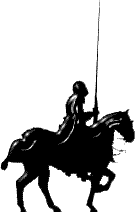
In Loving Memory Of My Father
Wayne R. Ryan
MM-3C Aboard The U.S.S. BROCK APD-93
HIGH SPEED TRANSPORT
& ALSO AS
MM-3C
Aboard The U.S.S GAINARD DD-706 AN ALLEN M. SUMNER CLASS DESTROYER
FOR SERVICE IN THE OKINAWA AREA DURRING WORLD-
WAR- TWO
Motto: Malo Mari quam Faedari, which means,
"I would rather die than be dishonoured." Origin of name:
The surname Ryan and its variants can trace its origin from Milesius King of the Milesians (or Celts)
King of Spain through the time of his son Heremon, first absolute King of Ireland, 504 BC and Cathair Mor, one of the most
renowned monarchs that ever held the Irish throne.
Territory and Strongholds of the Ryans
Killaloe Cathederal, County Clare.
This
Cathedral, erected by Donal Mor O Brien, King of Thomond, was granted to a member of the Ryan family in the 16th century.
Tara, County Meath.
The O'Ryans of
Idrone, County Carlow and the Mulryans of Owney, County Tipperary and Limerick were descended from Cathair Mor, High King
of Ireland, c300 A.D. who had his palace at Tara, County Meath.
Barony of Idrone, County Carlow
The
original family stronghold of Idrone relates to much of present-day County Carlow and traverses the River Barrow valley westward
into County Kilkenny. The O'Ryans were chiefs of Idrone, which territory nowadays is encompassed by the Barony of Idrone.
Cistercian Duiske Abbey, Craignamanagh, County Kilkenny.
This is one of the oldest buildings associated with the Ryan family that still remains intact in the Idrone
regions of County Carlow. Dermot O'Ryan of Idrone granted the land for this building in the 12th century. It is now beautifully
restored and used as the Parish Church, located in the centre of the town.
Baronies of Owney, County Limerick with Arra and Owney Beg, County Tipperary.
The Munster Branch of the family the Mulryans were chiefs of Owney favouring the
rich pastures of the Golden Vale in the counties Tipperary and Limerick. The territory of Owney in modern times consists of
the Barony Owney and Arra in County Tipperary and the Barony Owney Beg in County Limerick.
Cragg Castle, County Tipperary.
Most of the
Castles built by the Ryans (O Mulryans) when they arrived in the Owney territory of Munster were demolished or confiscated
by the Cromwellian forces in the 17th century. In the mid15th century the Earl of Ormond destroyed the Ryan stronghold, Cragg
Castle, six miles east of Killaloe. The ancient burial ground of the Tipperary Ryans was located one mile east of Cragg, where
today one can see many Ryan graves.
Ballymackeogh House, Newport, County Tipperary -
is located one of the best-preserved buildings County Tipperary associated with the Owney O Ryans. This beautiful building
Ballymackeogh House was for centuries, the home of a branch of the Owney O Ryans.
Abingdon Abbey and Castle, County Tipperary.
The
Earl of Ormond and in the 15th century destroyed the Ryan Castle at Abingdon in County Limerick. This is a site of an Abbey
and castle of Owney - the seat of John Ryan, Abbot in the 16th century.
Cully Castle, Newport, Tipperary.
This
is now named Castle Waller. The castle was confiscated by Cromwellian in the 17th century. The remains of this Ryan stronghold
can be seen at the present time.
Tyone House, Nenagh, County Tipperary
Malachi
Ryan once occupied this. His descendants (Thomas Ryan Riggs-Miller and his wife Nancy) reside at the adjacent townland of
Tullaheady.
The Spirit of St Louis,
which Charles Lindbergh flew across the Atlantic in 1927, was built in the USA by Ryan Aviation.
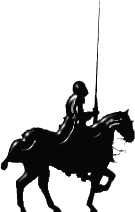
YOU HAVE TO STAND FOR SOMETHING
OR YOU'LL FALL FOR ANYTHING!!!
We encourage You to Support Youth & Veteran Programs in Your Community Together We CAN and MUST Make A Difference!!!!!!!
Because Our Youth Are Our Future!!!!!!!!
Sincerely Scott Huffman

| Part One: Swords and Daggers of the Heraldic Age
(Editor's Note: This is the first of a three part series on weapons of the heraldic age, their
construction and basic use. Part one deals with the various swords and daggers carried by the common soldier during this time
period.)
The Sword was the classic weapon for almost three millennia. In its earliest design, the "Queen of Battle" was crude but effective.
The original broadleaf shaped weapons made of bronze were efficient but lacked the strength for anything other than as a real
slicing or stabbing weapon. Classic sword fighting as presented in Hollywood movies simply did not exist because bronze weapons
would bend or break during any sort of heavy use. Any soldier who used his weapon to parry an opponent attack found himself
without one and died in battle.
With the advent of the Iron Age, the sword was greatly improved although the iron would still bend and the blade edge could
not stand any serious blow. But it was the material strength of iron and later steel that created the sword as the weapon
we know today.
A sword could be identified by the culture in which it was used. The 'Roman short sword' is an excellent example of this,
as weapons frequently dictated the fighting style or vice-versa. The Romans developed this fighting style to the point that
they defeated most of the ancient world with it. Ironically, the Romans got much of their style of fighting and weapons from
the Celts.
As with any effective weapon of battle, the sword went through stages of strength and power that affects all weapons worthy
of a defense. In the golden age of the sword, it had evolved into the classic weapon we know today. It was highly efficient
and deadly, as one could kill with the point, either of two edges, and with the pommel if properly trained. The sword also
came to possess strong symbolic meanings, different virtues being assigned to the edges. The quillion or crosspiece formed
across the handle of the sword resembled a Christian cross, furthering the symbolism and allowing the user to catch an opponent's
blade.
As armor improved, so did the size and effectiveness of the sword. This continued until the weight of armor worn by the
defender was great enough that a new tactic was developed. The full suit of armor had become so restrictive that a man wearing
it could not move quickly, and a man without such a suit, but with a light weapon, could easily outmaneuver and defeat his
enemy. In combination with the advent of the gun, the cycle of weapon and defense went full circle, and with the death of
the suit of armor, the modern rapier (or foil) was born.
It is difficult to discuss the sword in great detail, as each civilization developed its own variations of the weapon in response
to its culture and use. There was also constant argument among the users themselves as whether the point or the edge was the
more efficient weapon. Therefore, we will only discuss the main weapons or variants in use during the middle ages.
Baselard: A knife or short sword bearing a hilt or guard in the shape of the letter I, the guard allowed the user to
catch an opponent's blade. It quickly became the weapon of choice for many foot soldiers and was used in conjunction with
a rapier during the 17th and 18th Centuries.
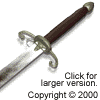 The Basic or Standard Sword: The weapon of the knight or trained soldier; a long, tapered, usually two-edged blade
ranging from less than three to more than six feet in length ending in a point which was sometimes used for thrusting. Swords
generally weigh less than you would believe, a 40-inch sword only weighing in the neighborhood of 3 and a half pounds. The
pommels on many swords are also thicker than they appear in most two-dimensional illustrations, being heavy to counter the
weight of the blade and balance the weapon in the hand. The Basic or Standard Sword: The weapon of the knight or trained soldier; a long, tapered, usually two-edged blade
ranging from less than three to more than six feet in length ending in a point which was sometimes used for thrusting. Swords
generally weigh less than you would believe, a 40-inch sword only weighing in the neighborhood of 3 and a half pounds. The
pommels on many swords are also thicker than they appear in most two-dimensional illustrations, being heavy to counter the
weight of the blade and balance the weapon in the hand.
Bastardsword: Also known as the hand and a half sword or Longsword. This sword was popular during the
1400's, and they were generally four feet in length. The main feature was a longer handle that allowed the blade to be used
in two hands, although it was short and light enough to use one handed when desired or necessary.
Broadsword: The Broadsword was the general blade in use from the sixth century on. It was usually from two-and-a-half
to three-and-a-half feet long with two edges and a one handed handle. It was light enough to swing all day and heavy enough
to impart a severe blow from its edge, which was surprisingly rarely sharpened. The thickness of the edge, between 1/8 and
1/16 of an inch was thin enough to concentrate the blow and do serious damage to the opponent.
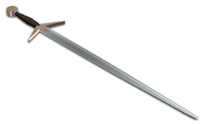 Claymore, Two-handed sword and Greatsword: The large two-handed swords were popular in Scotland during the 15th, 16th
and the 17th centuries. Ranging in length from just over four feet to six feet, they possessed handles that were 18" - 21"
in length. Overall the swords weighed much less than people think, most only six or seven pounds, although there are examples
that weigh as much as ten pounds. The term Claymore was also used to describe a Scottish broadsword with a basket hilt. Claymore, Two-handed sword and Greatsword: The large two-handed swords were popular in Scotland during the 15th, 16th
and the 17th centuries. Ranging in length from just over four feet to six feet, they possessed handles that were 18" - 21"
in length. Overall the swords weighed much less than people think, most only six or seven pounds, although there are examples
that weigh as much as ten pounds. The term Claymore was also used to describe a Scottish broadsword with a basket hilt.
Cutlass: A much heavier version of the saber. While its weight made it impossible to use in the manner of the Saber,
the cutlass had an advantage in that its weight and shape made it readily usable by the novice with deadly efficiency against
untrained opponents. Sailors and pirates mainly used the weapon.
Dagger: A short pointed knife with no guard. There were many forms of daggers worn during the Middle Ages. Knights
and squires at court wore daggers almost all the time in deference to the sword.
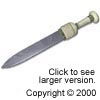 Dirk: The Scottish version of the dagger, it frequently had a blade as much as 12 inches long. The handle flared at
the base and before the blade to protect the user's hand and to aid in gripping the weapon. The Dirk was held ice-pick style
in the shield hand of the Scot during battle, while the Targe (shield) was held to the arm by two leather straps. Dirk: The Scottish version of the dagger, it frequently had a blade as much as 12 inches long. The handle flared at
the base and before the blade to protect the user's hand and to aid in gripping the weapon. The Dirk was held ice-pick style
in the shield hand of the Scot during battle, while the Targe (shield) was held to the arm by two leather straps.
Epee: French for Sword.
Falchion: A short, heavy, broad-bladed sword with a single edge, bearing a similarity to a heavy scimitar, also
an archaic term for any sword. Sometimes a converted sickle was called a Falchion.
Rapier: The rapier is strange as a sword weapon, as it sometimes had no edge at all, just a skinny supporting piece
of steel and a point. The main advantage of this weapon is its speed of use, as the weapon has a very light blade. The rapier
much resembles the modern fencing weapons of today although it is a little thicker. With proper training the weight of this
weapon allowed its user to fight almost without breaking a sweat.
Saber or Scimitar: A medium length single edged sword that was frequently used by officers and Calvary in the military.
Its curved shape made it easy to cut with but more difficult to use effectively unless the user had proper training. Its shape
and weight could be an advantage in battle, as the curve allowed the user to catch and pull away an opponent's blade. The
scimitar was an oriental version of the saber with a slightly more drastic curve to the blade. |

| Part Two-Siege and Missile Weapons
(Editor's Note: This is the second of a three part series on weapons of the heraldic age, their
construction and basic use. Part two deals with the missile weapons of the age with the exception of the gun and cannon.)
Missile weapons were the ancient standoff weapons, and allowed the destruction of enemy forces
and defensive structures with little personal danger. With the exception of the Bosson and Belfrie, siege weapons fall under
the general titles of bombards, catapults and Mangonel.
Most siege engines were invented over 2000 years ago by the Greeks and were little improved by the Romans. Development
stagnated over the period from 500 to 1500 AD, and there were no real improvements on this ancient artillery until the advent
of gunpowder and the first mortars.
The rest of this category contains the individual missile weapons. The javelin and the bow as personal weapons were limited
in range to less than 100 yards and basically remained unimproved over the last 10,000 years. The longbow and the arbalest
changed this, increasing the range to 300 yards with deadly accuracy and penetrating power.
Arbalest or Crossbow: The arbalest was introduced early in the 14th century. The crossbow consisted of a heavy bow mounted
on a stock that could be cranked or pulled into place using more leverage. The result was a very high-powered, low trajectory
weapon of great destructive potential. It fired a bolt, a shorter version of an arrow. The disadvantages of the Arbalest were
its slow firing rate and cost of manufacture. Therefore, the longbow remained the favored missile weapon of the 14th and 15th
century. From time to time various laws banned the crossbow, probably because it could penetrate the armor of the knight.
Ballista: Specifically the Ballista usually fired very heavy spears or bolts, when used against troops this would
clear a path, when used against a structure it could break a hole in the defenses. The ballista resembles a large crossbow
in design.
 Belfrie or Siege Tower: A rolling siege engine that worked as a portable system of ladders with a cover to protect
the soldiers inside from attack. It typically had a ramp that would drop on top of the defending wall to allow access. Belfrie or Siege Tower: A rolling siege engine that worked as a portable system of ladders with a cover to protect
the soldiers inside from attack. It typically had a ramp that would drop on top of the defending wall to allow access.
Bolts: Shortened arrows used in arbalests, small thick missiles capable of incredible penetration, even capable
of penetrating the plate armor of the time.
Bosson or Battering Ram: A 'battering ram' designed to pound down the gate on a besieged castle.
Catapult or Bombard or Mangonel: A piece of heavy ordnance for heaving missiles used during a siege. The missiles
could be stones, large spears, bolts and even flaming debris among other things.
Javelin: The javelin, while it greatly resembles the spear, is a lighter weapon used for throwing.
 Longbow: The weapon of the archer, compare it with the shorter composite bow of the Saracen, which had a shorter draw
but was easier to use from horseback. It is said that the Welsh developed the weapon, but the English mastered it after the
middle of the 14th Century. The longbow, with a draw from 30 to 36 inches, could launch an arrow more than 300 yards, was
deadly against opponents not defended by plate armor. This was one of the most effective weapons of the Middle Ages, but required
a high degree of skill. Archaeologists today can identify the skeletons of longbowmen from this period because of the twist
in their spines. This twisting was caused by the estimated 100 pounds of pull required to use the bows. Longbow: The weapon of the archer, compare it with the shorter composite bow of the Saracen, which had a shorter draw
but was easier to use from horseback. It is said that the Welsh developed the weapon, but the English mastered it after the
middle of the 14th Century. The longbow, with a draw from 30 to 36 inches, could launch an arrow more than 300 yards, was
deadly against opponents not defended by plate armor. This was one of the most effective weapons of the Middle Ages, but required
a high degree of skill. Archaeologists today can identify the skeletons of longbowmen from this period because of the twist
in their spines. This twisting was caused by the estimated 100 pounds of pull required to use the bows.
Onager: The Roman improvement of the catapult, this engine worked on torsion and had a large bucket that was filled
with the thrown item of choice.
Standard or Shortbow: This may be more properly represented as the Saracen bow, a bow of approximately 30 to 36
inch length that could be used in restricted quarters or by a rider of a horse. Its range was generally 100 yards or less.
The only improvement to this weapon over the time covered was the horn and sinew compound bow.
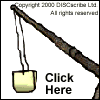 Trebuchet or Giant Sling: This siege weapon resembled the Catapult greatly. The major difference was that instead of
a basket it had a sling that could be filled either with one large stone or many smaller ones. It also worked under by use
of a counterweight instead of tension. Upon the weapons release a counterweight would fall and the sling would fling its contents
forward in the desired direction. Trebuchet or Giant Sling: This siege weapon resembled the Catapult greatly. The major difference was that instead of
a basket it had a sling that could be filled either with one large stone or many smaller ones. It also worked under by use
of a counterweight instead of tension. Upon the weapons release a counterweight would fall and the sling would fling its contents
forward in the desired direction.
|

| Part Three-Other Hand Weapons and Polearms
(Editor's Note: This is the third in a three part series on weapons of the heraldic age, their
construction and basic use. Part three deals with three different types of weapons: 1) those available to the peasant or surf
(the common man); 2) some more unusual weapons of soldiers or knights, and; 3) polearms.)
 Ball and Chain or Flail: Usually consisted of a short handle with a ball and chain attached. The advantage of this
weapon was the increased momentum the user could impart to the blows. The disadvantage was how easily the chain could be entangled
and taken away from its user. Ball and Chain or Flail: Usually consisted of a short handle with a ball and chain attached. The advantage of this
weapon was the increased momentum the user could impart to the blows. The disadvantage was how easily the chain could be entangled
and taken away from its user.
Battleaxe: The old Battleaxe was the weapon of choice of the large muscular warrior, especially when a large amount
of room was available to employ it. The weapon frequently had a wooden handle of a five-foot length with a leather thong on
the bottom. The top consisted of a double-sided axe usually with the addition of a spike on top of the handle. When the warrior
had room and could literally swing the weapon freely it could clear a radius of 8 feet around friend or foe.
Crudgel or Club: Just as it sounds, this weapon was only a club and its main use was in smashing blows to disable
or knock the opponent unconscious.
Hammer (warhammer), Martel, Horseman's Pick: A weapon consisting of a hammer head on one side and a spike on the
other, sometimes mounted on a short handle for use in one hand and other times mounted on a short shaft for use in foot combats.
Warhammers were frequently used in duels or in combats concerning points of honor.
Handaxe: The Handaxe or hatchet as it is known today was largely used by conscripts and newly recruited Militia.
It was a common weapon and used by most peasants and serfs in their daily routine. As such, it required very little or no
training to use. The main disadvantage of this weapon was its reach and its limited striking power.
 Lance (weapon used in the joust): The long shaft of ash tipped with a sharp iron or steel tip, usually between 9 and
14 feet in length. A vamplate was developed near the end of the 15th century to protect the hand and arm, and lance rests
were built into breastplates and shields from the late 14th century onwards to help steady the lance as the horse galloped
towards the target. The lance was not usually used for real combat. Lance (weapon used in the joust): The long shaft of ash tipped with a sharp iron or steel tip, usually between 9 and
14 feet in length. A vamplate was developed near the end of the 15th century to protect the hand and arm, and lance rests
were built into breastplates and shields from the late 14th century onwards to help steady the lance as the horse galloped
towards the target. The lance was not usually used for real combat.
Lochaber Axe: The Lochaber axe was the choice polearm of the Scot. The axe had an blade mounted under the end of
the shaft. Frequently this weapon had either a hook in the blade or added to the top of the shaft used to unseat mounted opponents.
 Mace and Morning Star: A short mass weapon not unlike a heavy club. After the 14th century the club end was often made
of metal and enhanced with spikes. Mace and Morning Star: A short mass weapon not unlike a heavy club. After the 14th century the club end was often made
of metal and enhanced with spikes.
Pike: The long spear, with a small steel head. Up to 20 feet in length, they were popular with the Scots during
the 14th, 15th, and 16th centuries. The use of compacted pikemen was a powerful counter to cavalry, but was usually checked
with arrows or missile fire.
Polearm: The general term for a group of pole-mounted weapons usually featuring a cutting or slashing weapon on
one end. The halberd, guisarm, bill, bec-de-corbin, and poleaxe are all specific kinds of polearms, rising in popularity during
the 15th and 16th centuries among the infantry. The main use of the polearm was in defense by the infantry against cavalry.
Poleaxe, pollaxe, polaxe: A knightly staff weapon, its head being an axehead, usually balanced by a hammerhead,
and surmounted by a steel spike. The shaft was protected by steel checks and the hand of the user by a steel rondel. The Poleaxe
was used from the 15th century for warfare.
Spear: The oldest form of staff weapon, intended primarily for thrusting. The war spear usually had a long, leaf-shaped
or triangular head. In common use during the entire time period, the spear ranged in length from five to nine feet. Anything
longer than this is usually considered a Pike.
Staff: The Staff was a commoner's weapon, as it only required a piece of wood to make. It could be used quickly
and had a good reach but was not normally deadly without bludgeoning. The Staff was frequently wrapped in metal studded leather
and sometimes had a metal point added to the end |
|
 |
|
List of Surnames
- Arms: Gules three griffin heads erased
argent
- Crest: A griffin sergeant azure holding a sword erect Proper.
- Origin of name: The surname Ryan and its variants can trace its origin
from Milesius King of the Milesians (or Celts) King of Spain through the time of his son Heremon, first absolute King of Ireland,
504 BC and Cathair Mor, one of the most renowned monarchs that ever held the Irish throne. The English translation of the
Irish versions of the surname O'Riain, O'Maoilriain, means 'the descendant (or follower) of Rian'.
The Ryan surname (and its variant forms) is the eight most numerous surname in
the whole of Ireland. There are an estimated 28,000 bearers of the name resident in the island at the present time. However,
we must not forget that there are possibly ten times that total of Ryans living outside the shores of Ireland - in the two
Americas, Canada, Australia, New Zealand, England, Europe, the African continent and, to a lesser extent, Asia and the rest
of the world.
- Motto: Malo Mari quam Faedari, which means, "I would rather die
than be dishonoured."
- Variations: Ryan, Mulrian, Mulryan, Riain, Royan, Ruane, Ruan, Ryane, Rynne,
O'Moelrian, O'Mulriain, O'Riain, Rouane, O'Ryan
The Ryans are directly descended from Drona, who was fourth in descent from Cathair
Mor, founder of the Drona tribe. The O'Riains, or anglicised Ryans, were chiefs of the tribe of Ui Drona (descendants of Drona),
anglicised Idrone, and settled in Carlow and Kilkenny where they gave their name to the area.
In the eleventh century, the Chief of Ui Drona (descendants of Drona) took the
surname of O'Ryan, and the clan continued to possess the original stronghold of the family Ui Idrone i.e. much of present-day
County Carlow and westward into County Kilkenny, in the vicinity of Graiguenamanagh.
In the late 12th century Dermot O'Ryan of Idrone granted land for the building
of an abbey at Graiguenamanagh. The Cistercian Duiske Abbey at Graiguenamanagh is one of the oldest buildings associated with
the Ryan family, and is still intact. It is now beautifully restored and is used as the Parish Church up to the present time.
The great historian, Geoffrey Keating, describes the Ryans as follows 'A Sept most
free and hospitable', and for their constant opposition to the English colonists, they had their possessions confiscated in
the Cromwellian, and Williamites periods.
The ancient Leighlin Cathedral, located to the north of Graiguenamanagh and about
five miles west of Leighlinbridge was the major church in the Diocese in the centre of Idrone territory. The Cathedral, which
is still used as a place of worship, was used for many events involving the Ryan family down through the centuries.
A number of significant houses identified with the family are located near Goresbridge
on the River Barrow, sixteen miles south of Carlow town. In the 19th century, they were recorded as Ballinise, Aughtelkane
Lodge and Ballycabus, and some are still occupied today. Seskin Ryan, a hamlet located to the south of Bagnelstown, County
Carlow has strong family ties and now consists of a few houses.
Although strictly outside the Idrone territory, Foulksrath Castle, eight miles
north west of Kilkenny City, was owned by the Ryan family for many years, and is now used as a youth hostel.
THE RYANS OF TIPPERARY AND LIMERICK
The O'Maoilriains, or
anglicised Mulryans, are directly descended from Fergus, ninth in descent from Cathair Mor and are said to have settled in
the 13th century in the rich pasturelands of the Golden Vale bordering Tipperary and Limerick.
The O'Maoilriains, who were chiefs of Owney, settled in that territory which is
now known as the Baronies of Owney, County Tipperary and Owney-beg in the east of County Limerick and later moved in to the
Barony of Kilnamanagh, County Tipperary, where they became very numerous and powerful.
The prefix Maol or Mul, which signifies 'bald' always referred to the O'Mulryans
of Owney but gradually became obsolete, and was developed by Dr. Petty when he completed the Civil and Down Survey's for the
Cromwelliam Government.
Most of the buildings constructed by the Ryans (O'Mulryans) when they arrived in
the Owney territory of Munster were demolished prior to, or during the 17th century when their properties were confiscated
by Cromwellian forces. One of the Castles destroyed in the mid-15th century by the Earl of Ormond was Cragg Castle in County
Tipperary, six miles south east of Killaloe. Situated on rocky, elevated ground overlooking the River Shannon, this stronghold
was built here because of its strategic location. One mile east of Cragg, in a valley, is the ancient burial ground of this
branch of the family. Passing through the double style in this cemetery, with its interesting coffin rest (possibly 18th century
or earlier) one can see many Ryan graves, and without undue difficulty, read inscriptions going back to the Great Famine era
of the mid-19th century.
Other Castles that were destroyed by the Earl of Ormond in the 15th century were
Abingdon, County Limerick, and nearby Owney Abbey. A number of Ryans are buried in an ancient but still used graveyard surrounding
the site of the ruined Abbey, and at a slightly lower level, stand the 20 ft. high remains of a square tower. Tradition suggests
that this building was a vicar's choral or other part of the old Abbey.
At Newport, County Tipperary, six miles north of Abingdon, is located one of the
best-preserved buildings associated with the Ryan clan. The delightful Ballymackeogh House was, for centuries, the home of
a branch of the family that originated in the Nenagh (County Tipperary) area. A Mr. Hurley who bought it in 1972 now privately
owns it. An ancient church and burial ground for this and other branches of the family down through the years are located
beside the long driveway leading to the House.
The ruins of Cully Castle are situated less than three miles from Newport, amongst
the foothills of the Slieve Felim Mountains. Confiscated from Teige Ryan by Oliver Cromwell's forces in 1642, this large fortress
with rounded corners was granted to a Hardress Waller who renamed it Castle Waller. Once a massive structure with at least
two small circular flanking towers, it is now an ivy-clad ruin showing traces of both periods of ownership, including a vast
two acres of orchards encircled by high walls.
Across the Shannon River in County Clare, the beautiful Cathedral erected by King
Donal Mor O'Brien of Thomond at Killaloe was granted to a member of the Ryan family when the monasteries in Ireland were destroyed
by King Henry VIII in the 16th century. Historical documents show that'William Ryane of Tipperary, Gent in consideration
of the sum of £6.13s.4d. was given it to hold forever' on the payment of a twentieth part of a Knight's fee and a
rent of four pence. Killaloe Cathedral is still in regular use, as the Church of Ireland's main church in the diocese of that
name. Another building that became the property of the Ryans in King Henry VIII's time was the old Augustine Priory at Tipperary
Town. This was granted to a William Ryan for £20.
A substantial Ryan castle is reputed to have existed at Solohead, five miles north
west of Tipperary Town. Situated in the midst of some of the best land in the Golden Vale, and halfway between the Tipperary
hills and the county's central range, this site was one of great importance through the centuries. Back in the 11th century,
the great King Brian Boru had a successful skirmish with the invading Danes at Sologhead. A significant ambush also took place
there in the Irish War of Independence earlier this century. Although the Castle and the nearby Abbey are no longer visible
gravediggers often discover the latters ancient walls. A fine new church is now located on the site. Ballyryan 'the town of
the Ryans' - is located near Sologhead and now consists of only a few houses.
The Ryans have left their mark not only in the traditional Owney territories, but
also all over mid and north Tipperary and East Limerick where they are to be found in almost every parish today. For instance,
Holycross Abbey, pine miles north of Cashel in County Tipperary, had an Abbot in 1455 named Matthew O'Mulryan. One of King
Donal Mor O'Brien's great buildings, Holycross, was recently extensively restored. Inch House, the home of a branch known
by that name is only seven miles from Holycross and is quite close to another prominent Ryan district, Borrisleigh, where
a branch of the family owned 906 acres of land in the 17th. century. Like the powerful Tyone branch of the family - just south
Nenagh, County Tipperary - many of the Ryans have lived in these areas for centuries but, no doubt, originated from within
the Owney territory. Cathair Mor, the Founder of the Clan, is reputed to have been herded across the south of Ireland between
the two ma-' territories of the family, Idrone and Owney.
PROMINENT RYANS
There were Ryans who bore this illustrious
name with honour and distinction in all walks of life. 'The Ryan Dynasty' refers to a remarkable family of twelve from Tomcoole
in the fertile farmlands of Wexford, were of the Leinster Branch, descendants of the Ryans of Idrone.
Dr. James Ryan, a Fianna Fail member of the Dail (the Irish Parliament) for Wexford,
was a senator and, as member of DeValera's Government, held at different times the post of Minister of Agriculture, Health,
Social Welfare. Kate married Sean T. O'Kelly who became President of Ireland and held office from 1945 to 1959. Phyllis, her
younger sister became his second wife after Kate's death. Other members of this talented twelve were farmers or priests and
the women married into politics and medicine.
The Owney Ryans also had their outstanding family. The Ryans of Knocklong, County
Limerick, have records going back to the 17th century. A Thaddeus Ryan fought at the Battle of Aughrim and the Siege of Limerick.
In the present time Thady Ryan has been Master of the Scarteen Hounds, the great Black and Tan foxhounds which his family
has bred for more than 300 years.
From this area was the rapparee, Eamonn Riain, author of the famed Irish song 'Eamonn
O Chnuic' (Ned of the Hill). He is said to have been a Jacobite officer who took to these hills after the Treaty of Limerick
(1691) and preyed on the English planters in North Tipperary.
There is a Ryan family in every county in Ireland but the main branches of the
family are associated with the provinces of Leinster and Munster.
|
 |
|
|
 |
|
|
|

